If you're new here, you may want to subscribe to my RSS feed. Thanks for visiting!
Author of Be Ready for Anything and Bloom Where You’re Planted online course
This weekend, most people’s refrigerators are so full with Thanksgiving leftovers that getting to door shut requires the family engineer to play Tupperware Jenga with all of the containers of food. Inevitably, in many households, much of the leftovers go to waste after the 10th turkey sandwich in a row.
In this economy, none of us can afford to let anything go to waste, however. There’s a lot more you can do with those Thanksgiving leftovers besides referring to your What To Do With Leftover Turkey cookbook. (Who knew there was actually an entire cookbook on this?!?) The preserving goes way past turkey – there are lots of tasty ways to preserve your other leftovers too.
Instead of fighting the Black Friday weekend crowds, spend the day adding things that are frugal and delicious to your pantry. Here are 3 ways to preserve your Thanksgiving leftovers.
Freezing
Nearly all leftovers can be successfully frozen and used in other meals. For Tess Pennington’s guidelines on freezing food, click HERE.
- Freeze vegetables in cheese sauce to be used later in a pureed soup. Cheesy cauliflower and cheesy broccoli soup are big hits in our household. Simply thaw the veggies in cheese sauce and add to some white potatoes boiled in water. Thin the mixture down as desired with milk and serve piping hot.
- Freeze chopped meat mixed with gravy as the basis for a future speedy stew. If you want, you can also add cooked carrots and roasted potatoes to the mixture.
- Freeze leftover dinner rolls. You can reheat them as needed to use as rolls or you can dice them finely and freeze them for use in stuffing.
- Freeze desserts in individual servings for brown bag treats. They’ll be thawed out and delicious by lunchtime.
- Freeze single servings of casseroles, lasagnas, etc. You’ll have the best lunches in the office!
Dehydrating
Another way to preserve your leftovers is by dehydrating them. Whether you have a commercial dehydrator or you use your oven on a low setting, you can fill many jars with home-dried holiday leftovers. If you’re new at dehydrating, you can find detailed instructions HERE. (Use this handy rehydration chart for bringing them back to life!)
- Dehydrate the remainder of your veggie tray. I find that veggies dehydrate very nicely when they are coarsely grated with the biggest holes in the cheese grater. Be sure and squeeze the excess moisture out with a paper towel to cut down on the drying time. (Ditto for your fruit tray!)
- Dehydrate leftover turkey or ham to be added to casseroles and soups.
- Leftover fruit can be pureed and then dehydrated into homemade fruit roll-ups.
- Dehydrate mashed potatoes, then run them through the blender for instant potato flakes. You can use these to thicken soups or gravies naturally. (Note: I haven’t done this but it sounds like it would work very nicely.)
- Dehydrate leftover stuffing, then rehydrate (“Stovetop Stuffing”-style) with broth when it’s time to serve it. Make sure to get it completely dry and crumbly.
Canning
Everyone knows that canning is my favorite way to preserve food. If you have some jars and fresh lids, your kitchen already contains everything you need to add an abundant amount of food to your stockpile. The following recipes are from my book, The Prepper’s Canning Guide. Turkey, veggies, and cranberry sauce will all make beautiful additions to your home-canned goods. Use these recipes as a guideline to adapt what you have left over to nutritious homemade meals in jars.
Canning Turkey in Broth
Bone broth is all the rage if you happen to follow the teachings of the Weston A. Price foundation. A cookbook based on Dr. Price’s findings recommends many different ways to prepare the broth, and recommends that every has at least a cup per day. Your Thanksgiving turkey carcass can provide you with jars and jars of delicious, nourishing broth. If you don’t have time to process your turkey immediately, wrap the carcass well and put it in the freezer until you do have time.
After a few meals of roast turkey, remove most of the meat from the bones and place it in the refrigerator. You’ll be left with a rather desolate-looking carcass. Put that in your crockpot along with the reserved neck and giblets (if you didn’t use those for gravy). Add some veggies from the holiday snack tray – carrots, peppers and celery are great additions! Add a couple of tablespoons of salt, a head of garlic and 4-6 onions. Note: there’s no need to peel the garlic and onions as long as they are organic – just wash them well. Fill the crockpot with water and add your favorite spices (not sage – it tastes terrible when canned). I used whole peppercorns, salt, oregano and bay leaves.
Put the crockpot on low for 12-14 hours and let it simmer undisturbed overnight. Zzzzzz……
The next day, strain the contents of the crockpot into a large container – I use a big soup pot and a metal colander. After allowing the bones to cool remove any meat that you would like to add to your soup. I always give our dog a big treat – a bowl of turkey with gristle, fat and skin. (She’s a little on the skinny side because she runs constantly when she’s outside so I think that the occasional fat intake is good for her.) She also likes the mushy carrots.
Take all of the meat that you put in the refrigerator the night before and cut it into bite-sized pieces. I like a mixture of light meat and dark meat for this purpose. Also cut up the meat you removed from the crockpot.
Place approximately 1 cup of turkey in each of your sanitized jars. (I ended up with about a cup and a half in each jar.) Add 1-2 cloves of garlic to the jars.
You will have a rich, dark beautiful stock from the overnight crockpot project. Ladle this into the jars over your cut-up turkey and garlic. Leave 1 inch of headspace at the top of the jars. If you run out of broth, top it up with water – don’t worry – your broth will still be very flavorful.
Wipe the lip of your jars with a cloth dipped in white vinegar. Place the lids on and process them in your pressure canner for 90 minutes at 10 pounds of pressure, adjusting for altitude.
Your result will be a deep golden, rich meaty soup. This is an excellent base for turkey and dumplings, as well as any type of turkey soup. When you’re ready to serve it, just throw in a handful of noodles or rice to cook in the broth as you heat it up.
Canning cranberry sauce
If you have leftover cranberry sauce, you may can it for future use. (In our house, I actually make a triple batch when I make cranberry sauce, just so I can put some up for later.) I like to use teeny little half pint jam jars for this.
- Heat the cranberry sauce to a simmer on the stovetop.
- Ladle the sauce into sanitized jars, leaving 1/4 inch of headspace.
- Wipe the rims of the jars, then place the lid on them.
- Process in a waterbath canner for 15 minutes, adjusting for altitude.
Thanksgiving Soup
This recipe is adapted from one in my book, The Prepper’s Canning Guide.
Round up whatever veggies that you have left over from Thanksgiving. Don’t worry if they have some butter and seasonings on them – it will all add to the rich flavor of your soup. However, if they are in a cream or cheese sauce, you need to rinse that off before canning.
My soup contains carrots that were cooked in honey, green beans with some butter, some diced sweet potatoes, and corn with butter. Use whatever you have. Don’t be shy about raiding your veggie tray either: chop your crudites into bite-sized pieces and add them raw to your jars – they’ll cook beautifully during the canning process.
- Add one cup of your vegetable mixture to each sanitized quart jar. If you want, throw in some peas and diced potatoes too.
- Add 1 cup of chopped turkey to each jar (dark meat is perfect for this!).
- Season with a clove of garlic and 1-2 tablespoons of chopped onion in each jar. Because the vegetables were already salted, I did not add any additional salt to my soup. If you have it on hand, you can also add some carrots and celery.
- Top your veggies and turkey with one cup of your delicious stock that you made above. Then fill it the rest of the way with water. The flavors will blend – don’t worry!
- Wipe the lip of your jars with a cloth dipped in white vinegar and then place the lids on.
- Process the soup in your pressure canner for 90 minutes at 10 pounds of pressure, adjusting for altitude.
Variation: If you want a different type of soup, add 2 tbsp of tomato paste to each jar and season with some Italian spices like basil and oregano.
At serving time, you can add some cooked rice, barley, or pasta to your soup.
Want more fantastic ideas for building your pantry?
Check out my online course, Build a Better Pantry on a Budget. You’ll get loads of ideas for stocking up with delicious, healthful food on the cheap.
What do you do with YOUR leftovers?
Do you eat them right away? Do you preserve them? Please share any ideas I haven’t covered in the comments below.
Resources
Here are some links to great leftover ideas for all those Thanksgiving goodies:
- The Thanksgiving Club Sandwich
- Thanksgiving Leftover Shepherd’s Pie
- What Do You Do With the Leftovers?
And some further resources:
- The Prepper’s Canning Guide
- Nourishing Broth: An Old-Fashioned Remedy for the Modern World
- Presto 23-Quart Pressure Canner and Cooker
- The Pantry Primer: How to Build a One Year Food Supply in Three Months
- The Prepper’s Cookbook: 300 Recipes to Turn Your Emergency Food into Nutritious, Delicious, Life-Saving Meals

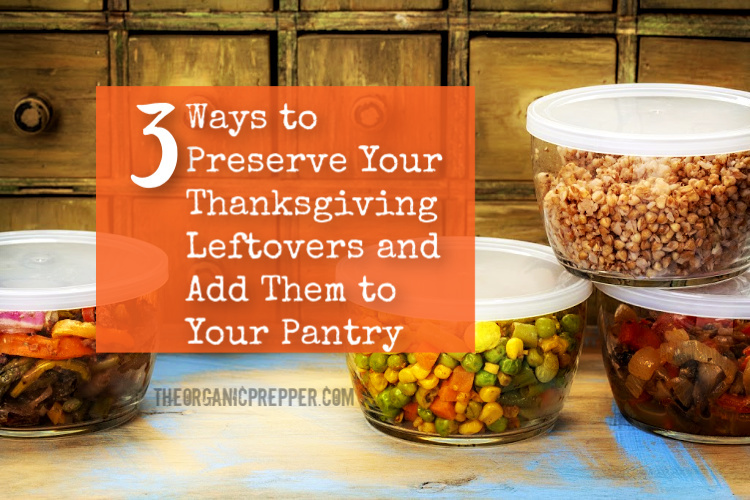
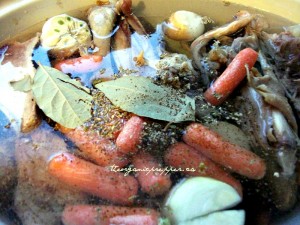
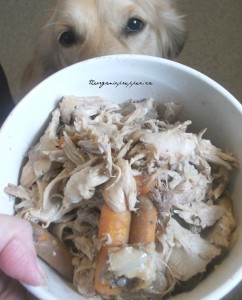
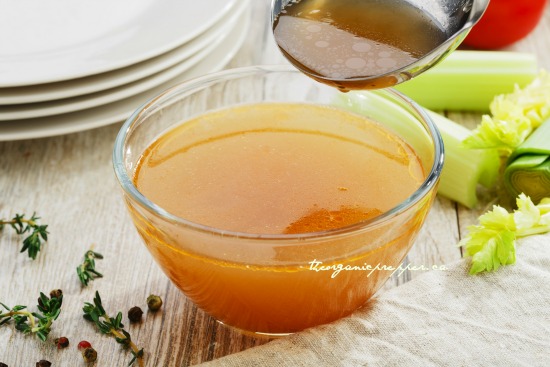
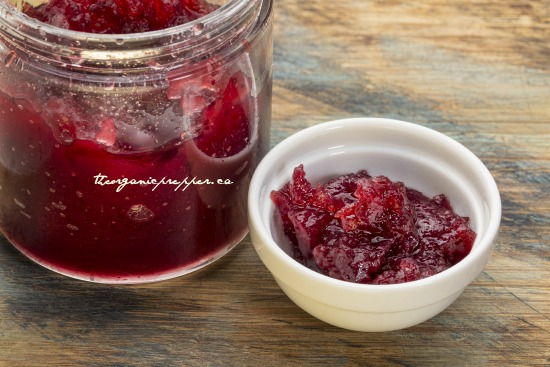
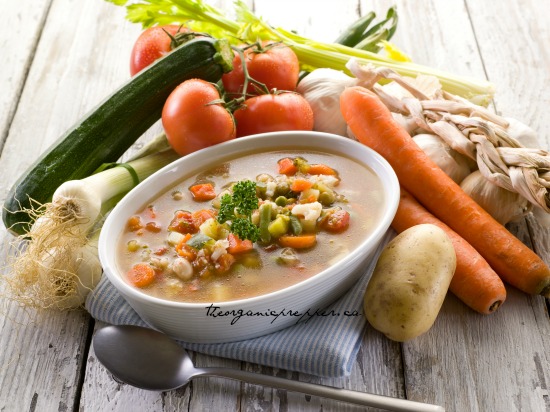















I would save some Daisy, but im sitting here still eating yesterdays…lol
The picture with the dog is priceless,,,,
She’s a little beggar, with those soulful eyes. 🙂 She knows how to work it.
We had a small early Thanksgiving in late October for family members who wouldn’t be able to attend in November. We managed to put up nine quarts of turkey stock and froze a fair bit of meat. We have leftovers from our Thanksgiving the other day and extended family members have agreed to save their carcasses for us to pick up in the next day or two. Once we have them we’ll be making (and canning) turkey chili, turkey stew, soup bases and turkey chili soup. We have a few jars already put away of cranberry sauce and plan on making more as well as canning the extra gravy. It makes “cooking” during the holidays so much easier.
While I agree that the house will smell wonderful in the morning if you make turkey stock in the crockpot, I always worry about leaving it on all night. Instead, I make all my stock in the pressure canner. 40 minutes at 11 pounds (I’m below 1000 feet above sea level) makes a fabulous stock & I’ll still have time to get it canned the same day.
That’s a fantastic idea! Never even thought about that. 🙂
the soup sounds so good and I love the cranberry sauce idea!But seriously does anyone really have mashed potatoes and gravy and stuffing left over? My boys make a beelinefor the frig the day after t day and for breakfast dinner and supper its mashed potatoes turkey and stuffing with butter and gravy poured over heated in microwave till gone! guess ill have to make the carcass soup wont be anything else. They also love cranberries so will have to make that triple batch!
Thanks you, this is perfect timing. I have already boiled down and deboned my turkey and was wondering how best to can it (with noodles/rice or without). Now I have a viable plan of action! 🙂
My daughter is saving her turkey carcass for me and I am putting it in my 18 quart roaster along with a bag of veggie scraps from the freezer and filtered water. I will cook it on simmer for 2 days or till I like it’s color and then can up in my pressure canner. I have heard you can cook the bones twice. Have you tried that?
before i simmer any bones, i pick the meat off and roast them in the oven (maybe with some root veggies for extra flavor). when they are brown, i remove them from the heat and pour water diluted wine over them, scraping the browned bits off the pan. i return them to low heat, stirring the bones around occasionally. when the liquid is good and brown, i put all in a large pot or crockpot and simmer with herbs and veggies. beautiful brown stock. the acid in the wine (or fruit juice) leaches calcium from the bones. what i don’t use right away, i freeze or can.
Emmer, I do mine the same way, roasting bones in the oven around 300 degrees for three or four hours to caramelize the bones before de-glazing and simmering in water. This brings out an intense, rich flavor, we do this with all our poultry, venison and elk bones. We usually get two runs of broth, and puree the veggies and add them back to make stock. We can this for 90 minutes at 15 lbs we are over 5000′. Possibilities for this stock are endless, had some a couple of weeks ago that was 5 years old and it was as good or better than the day it was made, Thanks for the tips Daisey
Love all the ideas, but PLEASE do not feed your dog onions or anything cooked with them. They’re super toxic for dogs!!